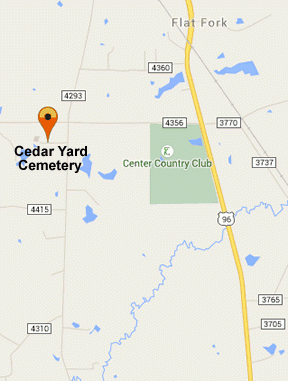February 21, 2016 - Although very few citizens of Shelby County know that there were once rural communities in their county named Dolce, Halfway, Thurman, Nettle Ridge, and Star Spring, the community of Cedar Yard is still known by some because they have loved ones buried there. Located only about five miles north of Center, there are the graves of some of our ancestors, dating back to 1848. Those families, represented by more than one grave, are Adams, Anderson, Armstrong, Atwood, Bittick, Chandler, Corley, Hayden, Howard, Humphries, Hussey, Moore, Norwood, Parker, Plain, Richardson, Roye, Scates, Smith, Todd, Walling, and Watlington.
 The cemetery was only one indication that Cedar Yard was a thriving rural community. A school was also located there as well as a post office. Still, it seems that however flourishing it was in the early settlement days of Texas, the community of Cedar Yard had probably begun its decline soon after the Civil War. This is suggested by the information available today about their post office. Isaiah Richardson was appointed the one and only postmaster in 1875, but the post office ceased operation the following year.
The cemetery was only one indication that Cedar Yard was a thriving rural community. A school was also located there as well as a post office. Still, it seems that however flourishing it was in the early settlement days of Texas, the community of Cedar Yard had probably begun its decline soon after the Civil War. This is suggested by the information available today about their post office. Isaiah Richardson was appointed the one and only postmaster in 1875, but the post office ceased operation the following year.
But before that, we get a glimpse of the activity in an around Cedar Yard (probably at its “zenith”) during the Regulator/Moderator conflict (1839-1844) by reading Middleton’s “History of the Regulators and Moderators.” From this source, the fact that Cedar Yard was the location of a major crossroads should not go unnoticed.
Hilliard's Fort (ed: important to the war’s history), was located some twelve miles north of Shelbyville, ten miles north of Jerry Beecham's, and some four miles north of Dave Strickland's where occurred the "School House Fight" (the Battle at Hilliards). The current state marker alleges the Battle at Hilliards took place near Cedar Yard Cemetery, but Middleton's directions would have Hilliard's Fort on the north side of the North Fork of Flat Fork of Tenaha Creek rather than at Cedar Yard. Cedar Yard Cemetery is situated at about the center of the David Strickland Headright.
During the period of the Regulator-Moderator War, the main road from Shelbyville to Pulaski (ed: now Panola County) and Taylor's Bluff in (ed: now Harrison County) passed north through Strickland's land, where it forked, the left fork leading toward Buena Vista and the right fork to Taylor's Bluff on the Sabine. (ed: This was probably not just a fork but a crossroads—Shelbyville to Buena Vista and Pulaski to Nacogdoches. There was also a wagon trail in the area (nearer to Buena Vista) that led to Logan’s Ferry. Of course, Center was not in existence at this time, but White Cottage (Newburn) was up the wagon trail toward Nacogdoches.)
In summary, Cedar Yard was a rural community in Shelby County, with a rather short and relatively undocumented history. It was probably vibrant in its day, its “day” starting as early as the 1830’s, with little remaining but a cemetery by the end of the 19th century. It is clear that it had most if not all the ingredients necessary to be considered a community of at least moderate size. Those ingredients included a short-lived post office, a 19th-century school which must have been privately established, and a cemetery, with possibly a church in close proximity. Perhaps the most important feature, however, was its location—at an intersection of roads connecting larger villages that must have been well travelled.









